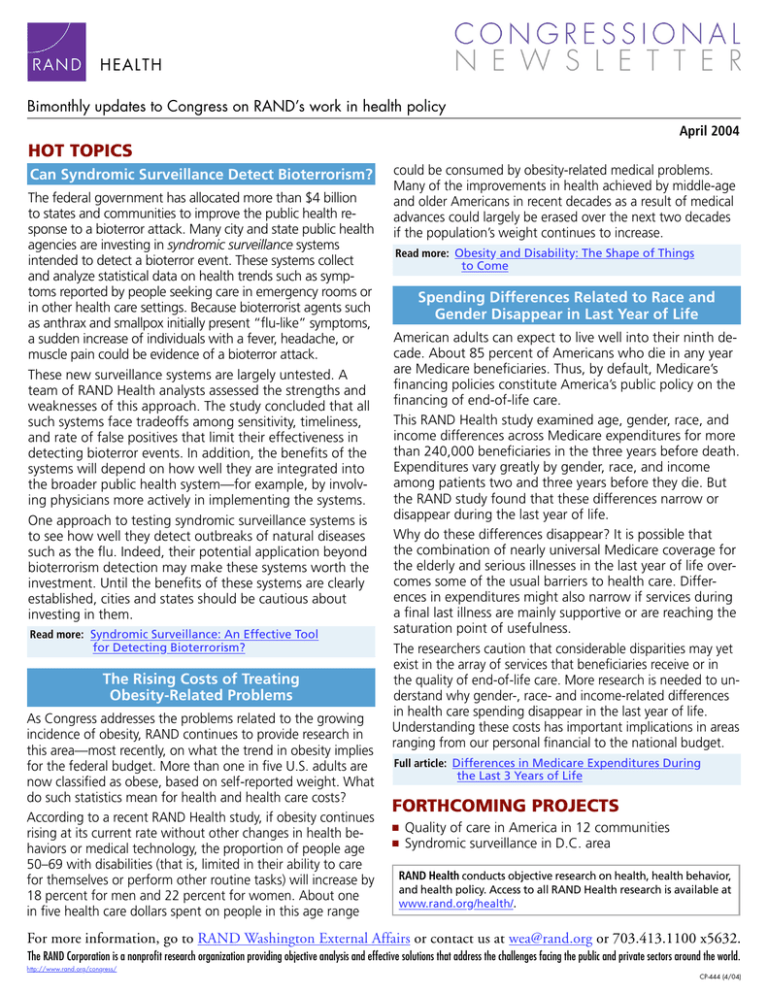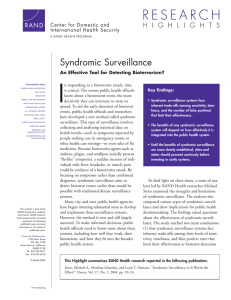HOT TOPICS Can Syndromic Surveillance Detect Bioterrorism?
advertisement

Bimonthly updates to Congress on RAND’s work in health policy April 2004 HOT TOPICS Can Syndromic Surveillance Detect Bioterrorism? The federal government has allocated more than $4 billion to states and communities to improve the public health response to a bioterror attack. Many city and state public health agencies are investing in syndromic surveillance systems intended to detect a bioterror event. These systems collect and analyze statistical data on health trends such as symptoms reported by people seeking care in emergency rooms or in other health care settings. Because bioterrorist agents such as anthrax and smallpox initially present “flu-like” symptoms, a sudden increase of individuals with a fever, headache, or muscle pain could be evidence of a bioterror attack. These new surveillance systems are largely untested. A team of RAND Health analysts assessed the strengths and weaknesses of this approach. The study concluded that all such systems face tradeoffs among sensitivity, timeliness, and rate of false positives that limit their effectiveness in detecting bioterror events. In addition, the benefits of the systems will depend on how well they are integrated into the broader public health system—for example, by involving physicians more actively in implementing the systems. One approach to testing syndromic surveillance systems is to see how well they detect outbreaks of natural diseases such as the flu. Indeed, their potential application beyond bioterrorism detection may make these systems worth the investment. Until the benefits of these systems are clearly established, cities and states should be cautious about investing in them. Read more: Syndromic Surveillance: An Effective Tool for Detecting Bioterrorism? The Rising Costs of Treating Obesity-Related Problems As Congress addresses the problems related to the growing incidence of obesity, RAND continues to provide research in this area—most recently, on what the trend in obesity implies for the federal budget. More than one in five U.S. adults are now classified as obese, based on self-reported weight. What do such statistics mean for health and health care costs? According to a recent RAND Health study, if obesity continues rising at its current rate without other changes in health behaviors or medical technology, the proportion of people age 50–69 with disabilities (that is, limited in their ability to care for themselves or perform other routine tasks) will increase by 18 percent for men and 22 percent for women. About one in five health care dollars spent on people in this age range could be consumed by obesity-related medical problems. Many of the improvements in health achieved by middle-age and older Americans in recent decades as a result of medical advances could largely be erased over the next two decades if the population’s weight continues to increase. Read more: Obesity and Disability: The Shape of Things to Come Spending Differences Related to Race and Gender Disappear in Last Year of Life American adults can expect to live well into their ninth decade. About 85 percent of Americans who die in any year are Medicare beneficiaries. Thus, by default, Medicare’s financing policies constitute America’s public policy on the financing of end-of-life care. This RAND Health study examined age, gender, race, and income differences across Medicare expenditures for more than 240,000 beneficiaries in the three years before death. Expenditures vary greatly by gender, race, and income among patients two and three years before they die. But the RAND study found that these differences narrow or disappear during the last year of life. Why do these differences disappear? It is possible that the combination of nearly universal Medicare coverage for the elderly and serious illnesses in the last year of life overcomes some of the usual barriers to health care. Differences in expenditures might also narrow if services during a final last illness are mainly supportive or are reaching the saturation point of usefulness. The researchers caution that considerable disparities may yet exist in the array of services that beneficiaries receive or in the quality of end-of-life care. More research is needed to understand why gender-, race- and income-related differences in health care spending disappear in the last year of life. Understanding these costs has important implications in areas ranging from our personal financial to the national budget. Full article: Differences in Medicare Expenditures During the Last 3 Years of Life FORTHCOMING PROJECTS ■ ■ Quality of care in America in 12 communities Syndromic surveillance in D.C. area RAND Health conducts objective research on health, health behavior, and health policy. Access to all RAND Health research is available at www.rand.org/health/. For more information, go to RAND Washington External Affairs or contact us at wea@rand.org or 703.413.1100 x5632. The RAND Corporation is a nonprofit research organization providing objective analysis and effective solutions that address the challenges facing the public and private sectors around the world. http://www.rand.org/congress/ CP-444 (4/04)




